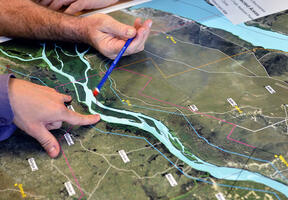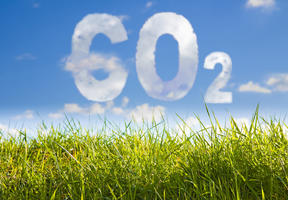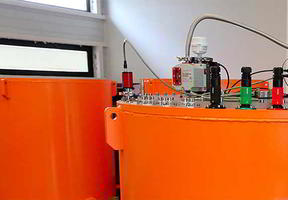Radioactivity, a Natural or Man-Made Phenomenon
10 min read
The decay of unstable atoms releases radiation, a phenomenon called . As unstable atoms exist in all matter, we are surrounded by natural radiation. Radiation can also come from man-made sources, through military, medical or industrial applications. Man-made radiation is closely measured and strictly controlled in order to avoid releasing it into the environment and living tissue.

© People who work in radiation zones wear dosimeters to measure the amount of radiation to which they are exposed and ensure that the dose does not exceed the authorized limit. AFP / KIMIMASA MAYAMA / POOL
To date, 118 chemical elements have been identified, characterized by a defined number of protons in their nucleus. These 118 elements encompass 2,800 isotopes (same number of protons, but a different number of neutrons). Of these 2,800 nuclei known today, only 264 are stable.
But nature doesn't like instability. Unstable isotopes will evolve towards a state of stability and gradually transform themselves in a process known as "decay" or "disintegration" by emitting one or more particles and electromagnetic rays. This is commonly referred to as radioactivity. In other words, radioactivity is the quest for stability1.
As the atoms decay, an element's radioactivity decreases. This is called . The time it takes for the radioactivity to decrease by half is called the half-life. Each physical element has its own half-life, which can vary from fractions of seconds to billions of years. The half-life of oxygen-15 is two minutes; iodine-131, eight days; carbon-14, 5,730 years; and -238, more than 4.5 billion years.
A natural or artificial phenomenon
To a greater or lesser extent, all matter in the universe is made up of radioactive atoms. We therefore live permanently in an environment that is naturally radioactive. Even the human body is slightly radioactive (about 150 becquerels per kilogram).
Natural radioactivity comes largely from the Earth, particularly granitic regions. It can also be of cosmic origin, due to nuclear reactions in the upper layers of the atmosphere. As a result, the higher we go in the atmosphere, notably during air travel, the more we are exposed to radioactivity. Air also contains radioactive substances, essentially .
More than two thirds of the radiation to which we are exposed each year comes from natural sources. The remainder is due to man-made sources, primarily medical exams and the treatment of certain illnesses (28%) and, to a very small degree, certain industrial activities ( -fired plants, nuclear or non-nuclear industries) and military applications.
The different types of radiation
There are three main types of radiation:
- Alpha radiation (α), made up of particles containing two protons and two neutrons and whose air range is a few centimeters. These particles can be stopped by an ordinary sheet of paper.
- Beta radiation (β), made up of electrons, which travel a few meters in the air. A sheet of aluminum foil, a window pane or a wooden plank are enough to stop them.
- Gamma radiation (γ), comprising electromagnetic rays that are much more penetrating than alpha and beta (they can travel several hundred meters in the air) and of the same nature as X rays. Thick layers of lead or concrete are needed to block them.
Units of measure
Scientists have defined three measures of radioactivity (see sidebar).
Radioactivity: Units of measure
- The intensity of the radioactive source is measured by the becquerel (Bq). One Bq corresponds to one disintegration per second (an infinitely small unit). The becquerel has replaced the earlier unit of measure, the curie.
- The quantity of radioactivity absorbed by inert material or living tissue is measured by the gray (Gy). This “dose” of radioactivity is the quantity of energy absorbed by a kilogram of matter.
- The quantity of radioactivity absorbed specifically by living tissue (plant, animal or human) is measured by the , with its sub-units the millisievert (mSv) and the microsievert (µSv). For beta and gamma radiation, 1 Sv is equivalent to 1 Gy.
The unit of measure with respect to living tissue is known as the sievert (Sv). Radioactivity has major effects on living tissue. In the case of acute radiation of the entire body, the first health effects appear above 5,000 mSv and the patient’s life is threatened.
National nuclear safety authorities are responsible for protecting the public and operators from the possible harmful effect of ionizing radiation. These effects are measured by the "dose rate", generally expressed in mSv per year. Natural radiation in France is about 2.4 mSv per year, but it reaches 260 mSv in certain regions of the world. It is not possible to establish a correlation between low doses (typically less than 100 mSv per year) and an excessive probability of radiation-induced cancers. French law has set strict limits on man-made radiation at 1 mSv per year. For professional personnel such as nuclear industry operators or medical workers, the limit has been set higher at 20 mSv, but without recognized risk. By way of comparison, one year aboard a space station corresponds to exposure of 100 to 300 mSv.
Sources





















